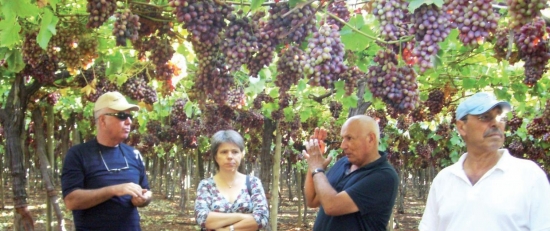
There they were, as far as the eye could see, verdant vines from which hung heavy clusters of grapes in varying shades of purple; the luscious appearance inviting us to savor the flavors. But the geometric perfection of each bunch prevented us from marring its beauty until Yigal Chen of the Ministry of Agriculture, agronomist and himself a cultivator, smilingly removed several bunches from the vines and handed them to our group to taste. Sweet, delicious and flavorful, we exclaimed in delight.
It was a humid August afternoon but the breezes that wafted over the hillsides of the Upper Galilee and the shade from the arbors of grape vines offered relief from the heat in the valley below. From our location on the Napthali Hills some two thousand dunams of grape cultivation stretched along the hillsides. This area had been covered with orchards of soft fruits which were planted and cultivated by farmers in the earlier days of the state. Sadly the late 80s saw a decline in market possibilities due to over-production and a lack of markets for export; profit margins shrank making it uneconomical to continue to produce a proliferation of peaches, apricots and plums. The costs and problems of storage and shipping of these fruits meant that Israel was unable to compete in overseas markets.
After painstaking research, advice and planning the trees were uprooted (surely with some heartache and sentiment) and the soil prepared for the planting of grape vines. Another factor that prompted this decision was water conservation as by using well designed watering systems present grape production requires half the amount of water that was needed for the deciduous fruits. Israeli agricultural advisors turned to Chile for advice and assistance as some of their climatic elements and elevation had similarities to those found in the Upper Galilee. Chilean grapes are famed for their lush virility and they are noted for their phylloxeria free and very mature long-living vines. The Chileans offered not only their advice but agreed to the purchase of seedlings of a number of varieties and special wooden supports for the vines as they grew and when they matured. They stressed the importance of using these mature wooden supports for the vines as they are specifically seasoned and can last for as long as fifty years providing the most preferable support for edible grape producing vines. The use of these long erect poles ensures that the grapes within the arbors that are formed have a 360 degree exposure to the sun as it moves across the sky ensuring even coloring and sweetness. Care of the grapes on the vine is also made easier using this method.
Over eight years have passed since the first 250 dunams were planted. During these years the Volcani Institute has been actively involved in experimenting further and ensuring that the grapes would have a high sugar content, aroma, well shaped berries and a good shelf life; all important factors for overseas marketing. Today the cooperative has 2,000 dunams under cultivation of which some 60 – 70% goes for export and the remainder is marketed for home consumption. Research and experimentation in storage and shipping methods has also ensured that the region can produce grapes for year round supply to overseas markets.
We passed through the arbors of lush fruit, stopping to admire and sample of the varied species – Red Globe, Black Finger, Autumn Black and even Crimson – each name also summoning a mental picture of color, shape and size. The afternoon ended with a tasting of Galilean wine, produced however on the other side of the valley.
-1372404808.jpg) Freda Keet at ESRA Tel Aviv
Freda Keet at ESRA Tel Aviv-1372524003.jpg) the key question
the key question -1372523803.jpg) Volunteering this year- English for Schools
Volunteering this year- English for Schools-1516356428.jpg) Hand in Hand Food Pantry
Hand in Hand Food Pantry Forever Slim
Forever Slim Food Foolish
Food Foolish Barbara Abraham
Barbara Abraham